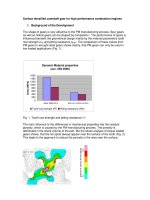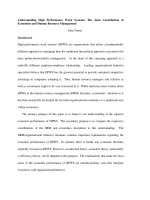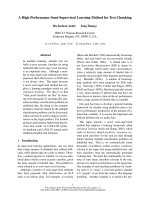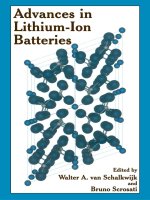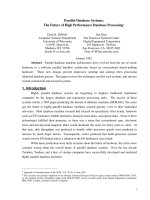High performance nanostructured phospho olivine cathodes for lithium ion batteries
Bạn đang xem bản rút gọn của tài liệu. Xem và tải ngay bản đầy đủ của tài liệu tại đây (2.89 MB, 156 trang )
HIGH PERFORMANCE NANOSTRUCTURED
PHOSPHO-OLIVINE CATHODES FOR LITHIUM-ION
BATTERIES
DING BO
A THESIS SUBMITTED
FOR THE DEGREE OF DOCTOR OF PHILOSOPHY
NUS GRADUATE SCHOOL FOR INTEGRATIVE
SCIENCES AND ENGINEERING
NATIONAL UNIVERSITY OF SINGAPORE
2014
Declaration
i
Declaration
I hereby declare that the thesis is my original work and it
has been written by me in its entirety. I have duly
acknowledged all the sources of information which have
been used in the thesis.
This thesis has also not been submitted for any degree in any
university previously.
_______________
Ding Bo
29 July 2014
Acknowledgement
ii
ACKNOWLEDGEMENT
First and foremost, my heartfelt thanks and sincere gratitude to my supervisors, Prof
Lee Jim Yang and Prof Lu Li, for their constant guidance, timely advice and
continuous encouragement all these years. They have supported me unequivocally
throughout my thesis project with their patience whilst allowing me the room to
explore. Their untiring dedications to imparting me with knowledge and enthusiasm
for scientific research have always been an invaluable source of inspiration.
I would like to express my sincere thanks to all my fellow colleagues in the research
groups, in particular, Dr. Zhang Chao, Dr. Ma Yue, Dr. Ji Ge, Dr. Yu Yue, Dr. Xu
Chaohe, Dr. Qu Baihua, Dr. Xiao Pengfei, Dr. Song Bohang, Dr. Lin Chunfu, Dr. Li
Siheng, Dr. Zhu Jing, Dr. Ye Shukai, Dr. Fan Xiaoyong, Dr. Song Shufeng, Mr. Yao
Qiaofeng, Ms. Lv Meihua, Mr. Zhan Yi, Mr. Yang Liuqing, Mr. Jiang Xi, Mr. Yan
Binggong,. I thank them for their valuable suggestions and stimulating discussions.
My sincere thanks to the technical staff in the Chemical and Biomolecular
Engineering department especially Ms. Chia Keng Lee, Mr. Evan Tan, Mr. Kok Hong
Boey, Mr. Liu Zhicheng, Mr. Mao Ning, and Dr. Yuan Zeliang. Without their superb
timely technical service, this study would not complete on time.
The financial supports from the National University of Singapore (NUS) Graduate
School for Integrative Sciences & Engineering (NGS) are greatly acknowledged.
Finally, I would like to thank my families for their unconditioned love and support.
Thanks to Niuzai for sharing joys and providing supports over all these years.
Table of content
iii
Table of content
ACKNOWLEDGEMENT II
SUMMARY………………………………………………………………………….VI
LIST OF TABLES VIII
LIST OF FIGURES IX
LIST OF ABBREVIATIONS XIV
CHAPTER 1 INTRODUCTION 1
1. 1 Background 1
1. 2 Objectives and scope 5
CHAPTER 2 LITERATURE REVIEW 8
2. 1 Electrochemistry of LiMPO
4
8
2. 2 Physical properties of LiMPO
4
10
2. 3 Phase behaviour and charge transport properties of LiMPO
4
12
2.3.1 Phase diagram 12
2.3.2 Electron conduction and Li
+
diffusion 16
2.3.3 Coupled Li
+
and polaron motions 19
2.3.4 Phase transformation 20
2.3.4.1 Equilibrium phase transformation 20
2.3.4.2 Non-equilibrium phase transformation 22
2. 4 Performance enhancement strategies 24
2.4.1 Lattice doping 24
2.4.2 Size reduction 30
2.4.3 Surface coating 35
2.4.4 Nanocrystallite Assembly 41
Table of content
iv
CHAPTER 3 ULTRA-THIN CARBON NANOPAINTING OF LIFEPO
4
BY
OXIDATIVE SURFACE POLYMERIZATION OF DOPAMINE 44
3. 1 Introduction 44
3. 2 Experimental section 47
3.2.1 Synthesis of LiFePO
4
nanoparticles 47
3.2.2 In-situ DOPA polymerization. 48
3.2.3 Materials characterization. 48
3.2.4 Electrochemical measurements. 49
3. 3 Results and discussion 49
3. 4 Conclusion 60
CHAPTER 4 A HIGH PERFORMANCE LITHIUM-ION CATHODE
LIMN
0.7
FE
0.3
PO
4
/C AND THE MECHANISM OF PERFORMANCE
ENHANCEMENTS THROUGH FE SUBSTITUTION 62
4. 1 Introduction 62
4. 2 Experimental section 64
4.2.1 Materials synthesis 64
4.2.2 Materials characterization 64
4.2.3 Electrochemical measurements 65
4. 3 Results and discussion 66
4. 4 Conclusion 76
CHAPTER 5 INCREASING THE HIGH RATE PERFORMANCE OF MIXED
METAL PHOSPHO-OLIVINE CATHODES THROUGH COLLECTIVE AND
COOPERATIVE STRATEGIES 78
5. 1 Introduction 78
5. 2 Experimental Section 80
Table of content
v
5.2.1 Materials Preparation 80
5.2.2 Materials Characterization 81
5.2.3 Electrochemical measurements 81
5. 3 Results and Discussion 82
5.3.1 Monodisperse Mn
1-x
Fe
x
PO
4
·H
2
O Microboxes 82
5.3.2 Monodisperse LiMn
1-x
Fe
x
PO
4
/C Microboxes 86
5.3.3 Electrochemical Performance and Structure Stability of LiMn
1-
x
Fe
x
PO
4
/C Microboxes 91
5. 4 Conclusion 96
CHAPTER 6 POROUS GRAPHITIC COATING OF LIMN
0.87
FE
0.13
PO
4
CATHODE FOR HIGH RATE AND SUSTAINED OPERATIONS IN LITHIUM
ION BATTERIES 98
6. 1 Introduction 98
6. 2 Experimental Section 100
6.2.1 Materials Preparation 100
6.2.2 Materials Characterization 100
6.2.3 Electronic and ionic conductivity measurements 101
6.2.4 Electrochemical measurements 101
6. 3 Results and discussion 102
6. 4 Conclusion 113
CHAPTER 7 CONCLUSION AND RECOMMANDATIONS 114
7. 1 Conclusion 114
7. 2 Recommendations for future work 117
REFERENCES…………………………………………………………………… 120
PUBLICATIONS 139
Summary
vi
SUMMARY
A large part of the success of lithium-ion batteries, the most advanced rechargeable
batteries in the market today, is based on a sustained continuing effort in materials
development. The needs for higher energy density, higher power density, lower cost
and safer electrode materials have in recent years identified phospho-olivine cathodes
as the substitute for the common, but expensive and environmentally compromising
LiCoO
2
-based cathodes. The performance of bulk and unmodified phospho-olivines is
however limited by a slow electrode kinetics. Although nanosizing and the use of
surplus surface carbon coating have made noticeable progress in performance
improvement, they inevitably carry an energy density penalty because of the low
packing density and the dead weight effect of the carbon coating.
This thesis project is an effort to minimize the compensatory effects in the
performance improvement of phospho-olivine cathodes. It aims to combine
composition and structural modifications rationally to fabricate phospho-olivine
cathodes with high energy, high rate capability, and cycle stability for the lithium ion
batteries. Specifically engineering of bulk properties (size reduction, substitutional
doping), surface modifications (controlled thickness, uniformity and quality of carbon
coating) and nanostructuring (nanocrystallite aggregation, encapsulation of phospho-
olivine in a porous carbon network) were used complementarily to increase the
electrochemical performance of phospho-olivines in high rate and extended use
applications.
Summary
vii
This thesis is topically divided into 7 chapters. Chapter 1 establishes the motivation
and the scope of work in this thesis study. Chapter 2 is a succinct review of recent
literature relevant to this research. Our first method of improvement of phospho-
olivines was ultrathin uniform carbon coating of LiFePO
4
by pyrolyzing
polydopamine-coated LiFePO
4
(Chapter 3). The carbon content was very low (1 wt%)
and yet the coated LiFePO
4
nanocrystallites demonstrated very high rate performance
(143 mAh/g at 1700 mA/g) and stable cycling. The good control of carbon coating
uniformity and thickness was made possible by a self-limiting in-situ surface
oxidative polymerization of dopamine by the Fe
3+
ions on a LiFePO
4
surface. We then
moved on to the design and synthesis of high energy density LiMnPO
4
by combining
Fe substitution, crystallite size reduction and carbon coating (Chapter 4). The
mechanism of Fe substitution was studied in sufficient detail to provide the guidance
for future material modifications. The volumetric capacity of Fe-substituted LiMnPO
4
was then increased by assembling the primary nanocrystallites into dense aggregates
(Chapter 5). The aggregates were also infused in a connected carbon network with
good porosity and electrical conductivity to provide an effective matrix for mixed
conduction. The rate performance and cycle stability of the Fe-substituted LiMnPO
4
aggregates were further enhanced by increasing the quality of the carbon network
through a nickel-catalyzed process (Chapter 6). The nickel catalyzed process not only
increased the electronic conductivity of the carbon coating, but also generated
mesopores in the carbon film for electrolyte perfusion. The conclusions from the
various projects in this thesis work are then examined collectively in Chapter 7 and
some suggestions for future work are made.
List of tables
viii
LIST OF TABLES
Table 2.1 Definitions of key performance indicators………………………… 10
Table 2.2 Energies of Li
+
migration in LiFePO
4
…………………………… 18
Table 2.3 Properties and performance of doped LiFePO
4
s…………………… 28
Table 2.4 Properties and performance of doped LiMnPO
4
s…………………….29
Table 2.5 Comparison of the performance of LiMPO
4
prepared by different
synthesis methods………………………………………………….…33
Table 2.6 Performance of LiFePO
4
with different surface coating materials… 38
Table 2.7 Properties and performance of LiMPO
4
aggregates.…………………42
Comparison of properties and performance of LiMnPO
4
based Table 6.1
cathodes…………… …………………………………………… 113
List of figures
ix
LIst of figures
Scheme 1.1 Schematic of a typical cylindrical lithium ion battery cell (left) and the
charging mechanism (right). 3
Figure 2.1 Crystallite structure of phospho-olivine LiFePO
4
viewed from the [001]
direction. 11
Figure 2.2 Phase diagrams of Li
x
FePO
4
(0<x<1) from temperature-controlled XRD
data. 14
Figure 2.3 Li
+
migration paths in a LiFePO
4
unit cell. Path A, [010] direction; path
B, [001] direction and path C, [101] direction. 17
Figure 2.4 Anisotropic diffusion of Li
+
in LiFePO
4
shown as green thermal
ellipsoids and the expected diffusion paths. The expected diffusion paths,
which are curved one-dimensional continuous chains of Li
+
motion, are
drawn as dashed lines to show how the motions of Li
+
evolve from
vibrations to diffusion. 18
Figure 2.5 Lithium concentration in a half-lithiated particle upon insertion with =
(a) 10
-4
and (b) 1. (c) Dependence of phase boundary inclination angle
on the dimensionless Li-surface insertion rate constant. Lithium
intercalation becomes surface reaction controlled as and bulk
diffusion controlled as . 21
Figure 2.6 Schematic view of the “domino-cascade’ mechanism for the Li
+
intercalation and deintercalation mechanisms in LiFePO
4
crystallites. a,
Schematic showing a view of the strains occurring during lithium
deintercalation. b, Layered view of the lithium
deintercalation/intercalation mechanism in a LiFePO
4
crystallite. 22
Figure 2.7 Room temperature electronic conductivity of doped phospho-olivines
Li
1-x
M
x
FePO
4
showing a factor of ~ 10
8
improvements over undoped
LiFePO
4
. 26
Figure 2.8 Phase diagram of Li
x
(Fe
1-y
Mn
y
PO
4
) system at 300 K. Squares denote the
boundaries between phase separated and single-phase regions. Region (a)
corresponds to a two-phase region associated with the Mn
3+
/Mn
2+
couple;
Region (b) corresponds to a single-phase region associated with the
Mn
3+
/Mn
2+
couple (shaded region) and the Fe
3+
/Fe
2+
couple (unshaded);
Region (c) corresponds to a two-phase region associated with the
Fe
3+
/Fe
2+
couple. Circles correspond to the boundary between the two-
phase and single-phase regions associated with Fe
3+
/Fe
2+
couple as
determined experimentally by Yamada et al. The dashed line denotes an
experimentally determined boundary between single phase Fe
3+
/Fe
2+
and
phase-separated Fe
3+
/Fe
2+
29
0
List of figures
x
Figure 2.9 Expected unblocked capacity vs channel length in LiFePO
4
for various
defect concentrations. 31
Figure 2.10 (a) TEM and (b) high resolution TEM images of LiFePO
4
/C prepared by
ex-situ carbon-coating (with sucrose) of microwave-solvothermal
synthesized LiFePO
4
nanorods followed by heat treatment at 700
o
C. (c)
TEM and (d) high resolution TEM images of the LiFePO
4
/C
nanocomposite obtained by in-situ carbon coating with glucose during
the microwave-solvothermal process, followed by heating at 700
o
C. 40
Figure 2.11 SEM images of spherical LiFePO
4
aggregates sectioned by a focused ion
beam at low (a) and high (b) magnifications. Cross-sectional TEM image
of LiFePO
4
(c) and the corresponding electron energy loss spectroscopy
image (d). 42
Scheme 3.1 Schematic illustrations of: (a) adsorbed dopamine molecules on LiFePO
4
nanocrystallite surface; (b) in-situ polymerization of dopamine by
surface Fe
3+
ions into a polydopamine shell on LiFePO
4
nanocrystallite;
(c) the thin carbon shell on LiFePO
4
nanocrystallite. 45
Figure 3.1 Characterizations of the solvothermally synthesized LiFePO4
nanocrystallites: (a) TEM and (b) HRTEM images (c) XPS spectrum.
Scale bars: (a) 50 nm; (b) 30 nm 50
Figure 3.2 TGA curves of LiFePO
4
/PDA and LiFePO
4
/C. Bare LiFePO
4
will gain 5
wt.% upon heating to 200-500, thus a bare 8-10 % lithium deficient Li
1-
x
FePO
4
would gain around 4.5 wt.% upon heating. Therefore the
estimated carbon amount in LiFePO
4
/C is around 1 wt.%. The estimated
PDA amount in LiFePO
4
/C is around 3.2 wt.%. The loss of weight of
both LiFePO
4
/PDA and LiFePO
4
/C is suspected to be caused by the
decomposition of lithium deficient Li
1-x
FePO
4
. 52
Figure 3.3 Characterizations of PDA-coated LiFePO
4
: (a) FTIR spectrum; (b) TEM
image; (c) and (d) HRTEM images. The PDA shell was uniformly
coated on the nanocrystallite surface to a shell thickness of 2-3 nm. Scale
bars: (b) 50 nm; (c) and (d) 20 nm. 53
Figure 3.4 Characterizations of carbon-coated LiFePO
4
nanocrystallites: (a) XRD
pattern; (b) SEM image; (c) TEM image; (d) and (e) HRTEM images.
The thickness of the uniformly coated carbon shell on LiFePO
4
nanocrystallites was about 1-2 nm. Scale bars: (b) 100 nm; (c) 50 nm; (d)
and (e) 5 nm. 55
Figure 3.5 N(1s) XPS spectrum of LiFePO
4
/C, the peak located at 398 eV
corresponding to pyridinic nitrogen, and peak located at 400 eV
corresponding to pyrrolic nitrogen. 56
Figure 3.6 Raman spectrum of LiFePO
4
/C. 56
Figure 3.7 Fe 2p
3/2
spectrum of LiFePO
4
/C. 57
List of figures
xi
Figure 3.8 First cycle charge and discharge profiles of LiFePO
4
/C. 57
Figure 3.9 Cyclic voltammograms of LiFePO
4
/C at 0.1 mVs
-1
. 58
Figure 3.10 Electrochemical performance of LiFePO
4
/C: (a) Rate capability; (b)
Cycle stability. 59
Figure 3.11 Comparison of rate performance with recently published high rate
LiFePO
4
and commercial LiFePO
4.
59
Figure 4.1 XRD patterns of a: LiMnPO
4
/C and b: LiMn
0.7
Fe
0.3
PO
4
/C, the inset
shows enlarged (121)(200) peak. 66
Figure 4.2 (a) SEM and (c) TEM images of LiMnPO
4
/C; (b) SEM and (d) TEM
images of LiMn
0.7
Fe
0.3
PO
4
/C. 67
Figure 4.3 (a) Voltammograms and (b) voltage profiles for LiMnPO
4
/C and
LiMn
0.7
Fe
0.3
PO
4
/C. 68
Figure 4.4 Nyquist plots of LiMnPO
4
/C and LiMn
0.7
Fe
0.3
PO
4
/C electrodes in test
cells. 71
Figure 4.5 Rate performance of (a) LiMnPO
4
/C and (b) LiMn
0.7
Fe
0.3
PO
4
/C. (c)
Plots of gravimetric energy density against C rate. (d) Cycling
performance of LiMnPO
4
/C and LiMn
0.7
Fe
0.3
PO
4
/C at 0.5 C. 73
Figure 4.6 Cyclic voltammograms of (a) LiMnPO
4
/C and (b) LiMn
0.7
Fe
0.3
PO
4
/C at
0.05 mV/s. (c) First cycle of charge and discharge profiles at 0.05 C (d)
Nyquist plots at different states of charge and discharge correspond to
sampling points in (c). 73
Figure 4.7 GITT plots of (a) LiMnPO
4
/C and (b) LiMn
0.7
Fe
0.3
PO
4
/C. 74
Figure 4.8 Li
+
Diffusivity as a function of lithium composition. 76
Figure 5.1 (a) Schematic showing the preparative steps in the formation of Mn
1-
x
Fe
x
PO
4
·H
2
O microboxes; (b) SEM and (c) TEM images of the
monodisperse Mn
1-x
Fe
x
PO
4
·H
2
O microboxes with insets showing an
individual microbox. 83
Figure 5.2 Morphology of Mn
1-x
Fe
x
PO
4
·H
2
O at reaction times of 15 min, 25 min,
30 min,40 min, 4 h. 84
Figure 5.3 Mn
1-x
Fe
x
PO
4
·H
2
O synthesized under different conditions: (a) addition of
H
3
PO
4
to the (Mn
2+
,Fe
3+
) ethanolic solution with stirring in 1min,
followed by 1000 rpm stirring at 40 °C for 1 h; (b) addition of H
3
PO
4
to
the (Mn
2+
, Fe
3+
) solution under sonication, followed by 1 more h of
sonication; (c) addition of H
3
PO
4
to the (Mn
2+
, Fe
3+
) solution under
sonication for 1 min, followed by 1000 rpm stirring at 40 °C for 1 h; (d)
addition of H
3
PO
4
to the (Mn
2+
, Fe
3+
) solution under sonication for 1
min, followed by incubation in Teflon-lined autoclave at 40 °C for 1 h.
84
List of figures
xii
Figure 5.4 XRD pattern of monodisperse Mn
1-x
Fe
x
PO
4
·H
2
O microboxes. 85
Figure 5.5 (a) Low magnification SEM image of Mn
1-x
Fe
x
PO
4
·H
2
O and (b) the
corresponding EDX spectrum. 85
Figure 5.6 The interconnected carbon coating on LiMn
1-x
Fe
x
PO
4
/C nanocrystallites
and (b) 3D network for electron transport in carbon-coated microbox; (c)
SEM and (d) TEM images of monodisperse LiMn
1-x
Fe
x
PO
4
/C
microboxes; (e) HRTEM image showing a thin layer of disordered
carbon on the nanocrystallite surface. 87
Figure 5.7 Thermogravimetric analysis of LiMn
1-x
Fe
x
PO
4
/C microboxes. 88
Figure 5.8 (a) SEM and (b) TEM images of SSR-nano. 89
Figure 5.9 (a) XRD patterns of the microboxes and SSR-nano; (b-e) TEM image of
a single microbox and corresponding element mapping, Fe (red), Mn
(blue) and P (green). 89
Figure 5.10 (a) Charge and discharge curves at 0.1 C of monodisperse LiMn
1-
x
Fe
x
PO
4
/C microboxes and SSR-nano. Cells were charged by the
constant current-constant voltage (CC-CV) protocol from 2.5 V to 4.5 V
at 0.1 C and then rested at 4.5 V until the current density decreased to
0.02 C; (b) rate performance of the monodisperse microboxes, same
charge protocol as that in (a) but the discharge was carried out at
different rates; (c) energy density vs C-rate plot; (d) cycling performance
at 0.5 C (Charging protocol: CC-CV, 0.2 C charging, holding at 4.5 V
until 0.05 C). 91
Figure 5.11 Cyclic voltammograms of LiMn
1-x
Fe
x
PO
4
/C microboxes at 0.05 mVs
-1
.
91
Figure 5.12 Electrode thicknesses of (a) SSR-nano and (b) LiMn
1-x
Fe
x
PO
4
/C
microboxes. 93
Figure 5.13 Charge and discharge curves of the microboxes. The electrode was
changed galvanostatically at 0.2 C followed by constant-voltage
charging at 4.5 V until the current decreased to 0.05 C. Discharge was
carried out galvanostatically at 0.5 C. 1 C=170 mAg
-1
. 94
Figure 5.14 (a) Microboxes electrode cycled at 0.2 C charging and 0.5 C discharging
rates, and (b) corresponding electrochemical impedance. 94
Figure 5.15 (a) SEM and (b) TEM images of the cycled microboxes electrode. 95
Figure 6.1 SEM images of LMFP-Ni (a) and LMFP (b). The circled area shows a
pore in the carbon film on LMFP-Ni. The arrow indicates a 3-4 nm thick
disordered carbon on the LMFP surface. 103
Figure 6.2 TGA curves of LMFP-Ni and LMFP 104
Figure 6.3 Raman spectra of LMFP-Ni (a) and LMFP (b). 105
List of figures
xiii
Figure 6.4 Ni 2p
3/2
XPS spectra of LMFP-Ni. The peaks at 862.5 eV and 856.6 eV
are assignable to Ni
2+
; and the peaks at 852 and 860 eV to metallic Ni.
Approximately 42 % of Ni is in the metallic state. 106
Figure 6.5 (a) TEM image of LMFP-Ni ; (b-d) Element maps of the sampled area.
107
Figure 6.6 Rietveld refinement of powder XRD patterns of (a): LMFP-Ni and (b)
LMFP. The refinements provided good reliability factors R
wp
=5.33 %
and 5.22 % for LMFP-Ni and LMFP respectively. The calculated cell
parameters for LMFP-Ni are: a=10.4174(6)Å; b=6.0824(3)Å;
c=4.7382(4)Å and V=300.226(4)Å
3
. The cell parameters for LMFP are:
a=10.4293(3)Å; b=6.0866(5)Å; c=4.7391(3)Å and V=300.835(5)Å
3
. 107
Figure 6.7 Impedance spectra of a): LMFP and b): LMFP-Ni. Pressed pellets were
used for the impedance measurements at 24
o
C. Geometric parameters of
the LMFP pellet: effective area = 0.196 cm
2
; thickness = 0.32 mm.
Geometric parameters of the LMFP pellet: effective area = 0.196 cm
2
;
thickness=1.32 mm. The measured data were fitted using the equivalent
circuits shown as insets. The fitted electronic resistance (R
e
) was 1289 Ω
for LMFP and 3429 Ω for LMFP-Ni. The fitted ionic resistance (R
i
) was
941 Ω for LMFP and 1554 Ω for LMFP-Ni. 109
Figure 6.8 Rate performances of LMFP-Ni and LMFP. 110
Figure 6.9 Cyclic voltammograms of a): LMFP and b): LMFP-Ni at a scan rate of
0.05 mV/s. 110
Figure 6.10 Typical discharge rate profiles of a): LMFP and b): LMFP-Ni. 110
Figure 6.11 Comparison of energy densities of LMFP and LMFP-Ni at different
discharge rates 111
Figure 6.12 Cycle performances of LMFP-Ni and LMFP. 112
Scheme 7.1 Alignment configurations of basal planes of the graphitic layer to the
nanocrystallite surface. 118
List of abbreviations
xiv
LIST OF ABBREVIATIONS
3D 3 dimension
CC-CV Constant current-constant voltage
CE Coulombic efficiency
CV Cyclic voltammetry
CVD Chemical vapor deposition
DEC Diethylene carbonate
DMC Dimethyl carbonate
DOPA Dopamine
EC Ethylene carbonate
EDX Energy dispersive X-ray spectroscopy
EIS Electrochemical impedance spectroscopy
EV Electric vehicle
FESEM Field emission scanning electron microscopy
FETEM Field emission transmission electron microscopy
FTIR Fourier transform infrared spectroscopy
GGA Generalized gradient approximation
GITT Galvanostatic intermittent titration technique
GO Graphene oxide
HRTEM High-resolution transmission electron microscopy
LDA Local density approximation
LFP LiFePO
4
LMFP LiMn
0.87
Fe
0.13
PO
4
List of abbreviations
xv
LMFP-Ni Ni
2+
added LiMn
0.87
Fe
0.13
PO
4
NMP N-methylpyrrolidone
PDA Polydopamine
PEV Plug-in electric vehicle
PHEV Plug-in hybrid electric vehicle
PVDF Polyvinylidene fluoride
SEI Solid electrolyte interphase
SEM Scanning electron microscopy
SHE Standard hydrogen electrode
SSR-nano Nano LiMn
0.7
Fe
0.3
PO
4
TEM Transmission electron microscopy
TGA Thermogravimetric analysis
XPS X-ray photoelectron spectroscopy
XRD X-ray diffraction
UV Ultraviolet
Chapter 1
1
CHAPTER 1 INTRODUCTION
1. 1 Background
Concerns for increasingly severe climate have accelerated the development of
renewable energy such as solar, wind and waves to reduce our reliance on fossil fuels.
The supply of energy from these renewable sources is however intermittent; and the
mismatch between energy supply and demand has to be mitigated through the
installation of energy storage systems. There can also be demand-side intermittency
caused, for example, by grid-connected plug-in electric or hybrid-electric vehicles
(PEVs or PHEVs). While there is a myriad of energy storage technologies; utilization
considerations clearly prefer technologies which can store and release energy in its
highest energy form; i.e. as electrical energy. Rechargeable batteries are devices
which enable energy storage and release directly as electricity; by means of highly
reversible electrochemical reactions. The most advanced rechargeable batteries on the
market today are the lithium-ion batteries. They have about 2.5 times of the energy
density of other rechargeable batteries [1]; and are known for their good cycle life,
absence of memory effects; and high rate performance. Such a strong suite of
application properties has kept the market dominance of lithium ion batteries (most
evidently in portable electronic products) since their commercialization by Sony in
1991 [2].
A lithium ion battery may contain one or more interconnected battery cells to deliver
the desired voltage and capacity. There are four major components in a typical battery
cell (Figure 1.1): cathode, anode, electrolyte and separator. Each of these components
Chapter 1
2
provides a specific function. Electrical energy is stored through spatially separated
electrochemical reactions by supplying energy to the cell (“charging”) from an
external electrical power source (“charger”). During charging electrons are moved
from the cathode to the anode in the external circuit. Concomitantly lithium ions
migrate from the cathode to the anode through the electrolyte in the cell interior to
maintain overall charge balance. In a way the low energy electrons in the cathode are
energized to a higher energy level in the anode and stored there. The reverse process
occurs during discharge where the higher energy electrons in the anode flow naturally
“downhill” to the cathode through a load placed in the external circuit.
Scheme 1.1 Schematic of a typical cylindrical lithium ion battery cell (left) and the
charging mechanism (right).Reprinted with permission from ref. [3]. Copyright from
Brain, Marshall. "How Lithium-ion Batteries Work" 14 November
2006. HowStuffWorks.com.< />tech/lithium-ion-battery.htm> 26 July 2014.
The lithium-ion batteries required for EV applications or grid-scale electrical energy
storage are much larger. Cost, safety and durability considerations; more so than
performance, weigh in heavily in decision making regarding their suitability. Hence
despite more than two decades of research, the lithium ion battery technology is by
and large only optimized for small devices and portable applications.
Chapter 1
3
The energy density of a battery cell is the product of cell voltage (V) and cell capacity
(Q). Cell capacity relates to the charge stored in a battery; while cell voltage is the
difference between the electrode potentials of the cathode and anode. The energy
density of lithium-ion battery is primarily limited by the performance of the cathode
material. The calculations from Tarascon et al. showed that a doubling of the capacity
of the cathode material would increase the cell energy density by 57 %, whereas a ten-
fold increase in the capacity of the anode material would only increase the cell energy
density by 47 % [4]. Hence the development of cathode materials with greater
capacity or higher electrode potential for Li
+
storage/extraction reactions is the most
effective means to substantially improve the cell energy density.
LiCoO
2
and its variants are the most common cathode materials for small lithium ion
batteries; a trend that persisted since the inception of early lithium-ion batteries [5, 6].
However, high cost, chemical instability and associated safety issues of delithiated
LiCoO
2
have diminished the interest in the continued use of this cathode material for
EVs or other large-scale applications [7, 8]. Since the electrode potential of
intercalation compounds is dependent on the iono-covalency of the metal-oxygen
bond, the substitution of oxide by the phosphate group (
3
4
PO
) decreases the iono-
covalency of the metal-oxygen bond, which raises the electrode potential relative to
the oxide. The strong P-O bonds also increase the structural stability of the cathode
material. Hence the phospho-olivine (LiMPO
4
, M=Fe, Mn) family of cathode
materials first discovered by the Goodenough group has quickly gained traction as the
cathode material for large-format lithium-ion batteries [9]. The application
performance of LiMPO
4
has also improved significantly over the years but much
Chapter 1
4
work is still needed to overcome some of the issues unique to the phospho-olivine
cathodes.
A significant drawback brought about by
3
4
PO
substitution is a large material band
gap caused by the inductive effect of
3
4
PO
, which increases the ionicity of the metal-
oxygen bond [4, 10]. The
3
4
PO
substitution improves chemical stability but also
decreases electronic and ionic conductivities at the same time. The electronic and
ionic conductivities of LiMPO
4
can be improved by preparing these materials at the
nanoscale since the time scale for electron and Li
+
diffusion varies with the square
root of the crystallite size. These nanocrystallites must additionally be carbon-coated
so that their rate performance would not be limited by extrinsic electrical resistance
[10]. The carbon coating also decreases the direct contact between the cathode
material and the electrolyte to minimize electrode corrosion by aggressive electrolyte
[11, 12]. The combined use of crystallite size reduction and carbon coating has
significantly improved electrochemical activity and hence the practicality of LiMPO
4
[13]. However, downsizing the LiMPO
4
crystallite size and carbon coating can come
at a price - Extensive diminution of the crystallites in conjunction with the use of
electrochemically inactive low density carbon can substantially reduce the volumetric
energy density of nanocarbon-LiMPO
4
composites [14, 15]. There is therefore a need
to optimize the crystallite size and reduce the carbon coating thickness to mitigate the
volumetric energy density penalty in nanosizing. The carbon coating can in principle
be reduced if the carbon coating quality (conductivity and uniformity of coverage and
porosity) is high. In addition, the use of mischemetal (e.g. mixing of Fe and Mn) in
the LiMPO
4
framework can also increase the energy density of LiFePO
4
by up to 20
%. However, the improved lithiation/de-lithiation kinetics due to the co-presence of
Chapter 1
5
Fe and Mn in the LiMPO
4
framework is not fully understood. A detailed examination
of the improved performance can lead to a better understanding of the mechanism and
contribute to the further improvements of phospho-olivines. The assembly of
nanocrystallites into micrometer sized aggregates can also be an effective means to
increase the volumetric energy density [16]. However, the assembly of
nanocrystallites needs to be carefully controlled to provide connectivity of porosity in
the aggregate structure for Li
+
diffusion. The assembly also needs a contiguous
coating of conductive carbon as embed current collectors in the aggregate structure.
Finally convenient methods of preparation must also be developed to translate the
design into actual materials for testing. The objective of this thesis is to improve the
usability of LiMPO
4
cathode materials through rational materials design and synthesis.
The detailed activities in this thesis project are outlined in the next section.
1. 2 Objectives and scope
This thesis is aimed at increasing the rate performance, energy density and cycle
stability of LiMPO
4
cathode materials. Hence, the design and synthesis of LiMPO
4
cathode materials with the desired improvements are the main objective of this thesis.
The emphasis is on the engineering control of crystallite size, elemental substitution,
carbon coating, and nanocrystallite aggregation. This is accompanied by several
mechanistic investigations aiming to gain further insights for design and synthesis
improvements. The chapters of this thesis are arranged in the order of cathode
materials of increasing energy density; from a new method of carbon-coating
LiFePO
4
to finally high quality carbon-embedded LiMn
0.87
Fe
0.13
PO
4
aggregates. The
following are highlights of some of the original approaches to material modifications
in this study:
Chapter 1
6
1. Concurrently high rate performance and high energy density of LiFePO
4
were
achieved by keeping the conductive carbon coating on LiFePO
4
to a very thin
layer (1 – 2 nm, in order to reduce the use of inactive carbon which carries an
energy density penalty) but maintained full and uniform coverage on the
LiFePO
4
crystallite surface. Conventional carbon deposition methods (carbon
chemical vapor deposition, decomposition of a sugar coating and etc.) lack
good control of carbon film thickness and uniformity because of the weak
physical bonds between carbon and the substrate. We made use of the redox
reaction between dopamine and surface Fe
3+
on LiFePO
4
to form a self-
limiting chemically bonded carbon film which was ultrathin, uniform in
thickness and highly conductive.
2. The electrochemical activity of LiMnPO
4
was increased by a controlled
substitution of Mn
2+
ions by Fe
2+
ions. The resultant LiMn
1-x
Fe
x
PO
4
nanocrystallite coated with nanoscale carbon has the promise of a high energy
density cathode material. The mechanism of Fe
2+
substitution of LiMnPO
4
was also studied to gain a better understanding of the electrochemistry of co-
substituted LiMn
1-x
Fe
x
PO
4
and to provide performance enhancement
guidelines and strategies.
3. A facile precipitation method was developed to produce LiMn
1-x
Fe
x
PO
4
as
aggregated nanocrystallites to increase the material bulk density, and
consequently the energy density of the cathode. A continuous carbon network
was used to electrically integrate the nanocrystallites and assimilate the
nanocrystallites. The aggregation of nanocrystallites not only increased the
Chapter 1
7
volumetric energy density but also reduced the amount of carbon needed to
electrically integrate the nanocrystallites. Analysis of the experimental results
resulted in some useful guidelines for the design and synthesis of high energy
density phospho-olivine cathode materials.
4. A novel nickel catalyzed graphitic carbon network was also used as a highly
conductive medium for embedding the LiMn
1-x
Fe
x
PO
4
aggregates. The
mechanisms of nickel catalysis of carbon graphitization and of pore formation
in the carbon film were investigated. The high quality of such a carbon
network was confirmed by different analytical techniques. This catalytic
process can provide a universal method for improving the electronic and ionic
conducting properties of carbon coating for electrochemical systems.
Chapter 2
8
CHAPTER 2 Literature Review
This chapter provides a succinct account of the major topics relevant to this research.
It begins with a summary of the electrochemistry of LiMPO
4
, followed by a quick
review of their physical properties, phase behavior, phase transformation and charge
transport mechanisms. The chapter closes with a discussion of the strategies for
improving the practical performance of LiMPO
4
based on the current understanding
of their electrochemistry and phase behavior.
2. 1 Electrochemistry of LiMPO
4
The electrochemistry of LiMPO
4
as the cathode of rechargeable lithium-ion batteries
is commonly evaluated in a Li | LiPF
6
(1M) | LiMPO
4
battery cell where LiPF
6
(1M)
is the electrolyte and Li metal is the anode. The Li metal in this cell configuration
serves as both counter and reference electrodes. The charge and discharge reactions of
a LiMPO
4
cathode may be summarized by Equation 2.1. In the charge half reaction,
Li
+
and electron are extracted from LiMPO
4
to leave behind the oxidation product
MPO
4
. The process is reversed in the discharge reactions where Li
+
and electrons are
reinserted into MPO
4
to reform the LiMPO
4
phospho-olivine. The electrode potential
where the cathode reaction occurs depends on the choice of M (3.45 V vs Li
+
/Li for
LiFePO
4
and 4.1 V vs Li
+
/Li for LiMnPO
4
). All electrode potentials in this thesis are
cited with respect to the Li
+
/Li reference, unless otherwise stated.
Cathode: 2.1
The key performance indicators of a LiMPO
4
material are: (1) specific capacity
(charge stored/retrieved per unit weight); (2) volumetric capacity (charge
Chapter 2
9
stored/retrieved per unit volume); (3) specific energy density; (4) volumetric energy
density; (5) rate performance (chargeability at different current densities); (6) cycle
stability; and (7) coulombic efficiency (discharge specific capacity/charge specific
capacity). The definitions of these terms are given in Table 2.1.
Table 2.1 Definitions of key performance indicators
Indicator
Definition
Remarks
Specific capacity
( / )
specific
nF
Q mAh g
M
(LiFePO
4
: 170 mAh/g; LiMnPO
4
171 mAh/g)
specific
Q
, specific capacity; n, number of
electrons transferred; F, Faraday
constant; M, molar weight of LiMPO
4
Volumetric capacity
( / )
volumetric
molar
nF
Q mAh g
V
(LiFePO
4
~ 600 mAh/cm
3
; LiMnPO
4
~ 580 mAh/cm
3
)
volumetric
Q
, volumetric capacity; n,
number of electrons transferred; F,
Faraday constant; V
molar
, molar volume
of LiMPO
4
Specific energy
Density
2
1
()
(mWh/ g)
V
V
Specific
Q V dV
E
M
(LiFePO
4
~ 580 mWh/g; LiMnPO
4
~ 700 mWh/g)
Specific
E
, specific energy density; Q,
capacity; V, voltage of the electrode; M,
molar weight of LiMPO
4
Volumetric energy
Density
2
1
3
()
(mWh/ cm )
V
V
Volumetric
molar
Q V dV
E
V
(LiFePO
4
2000 mWh/cm
3
; LiMnPO
4
2400 mWh/cm
3
)
Volumetric
E
, volumetric energy density;
Q, capacity; V, voltage of the electrode;
V
molar
, molar volume of LiMPO
4
Rate performance
Capacity at different current densities (denominated in C
rate; 1 C = 170 mA/g, nC = n×170 mA/g)
-
Cycle stability
Capacity retention over N number of cycles
-
Coulombic
efficiency
arg
arg
100%
disch e
ch e
Q
CE
Q
CE, Coulombic efficiency;
argdisch e
Q
,
discharge capacity;
argch e
Q
, charge
capacity

